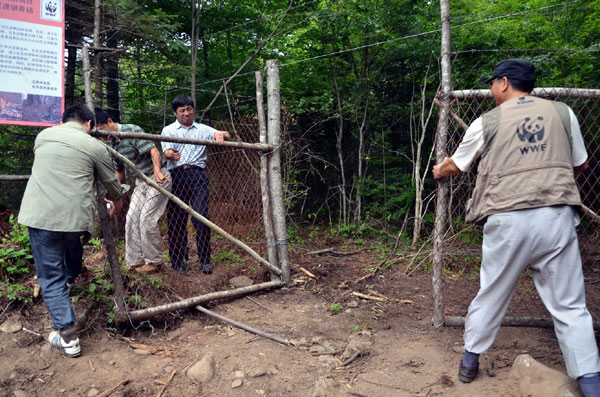Over 30 deer released to appease tigers
 0 Comment(s)
0 Comment(s) Print
Print E-mail China.org.cn, July 30, 2012
E-mail China.org.cn, July 30, 2012
More than 30 captive red and sika deer were released into the wild on Sunday in Northeast China's Wangqing Nature Reserve, in a bid to reestablish the food chain for wild Siberian tigers.
 |
|
Personnel from the World Wild Fund for Nature and the Forestry Department of Jilin Province open a fence to release deer into the wild at Wangqing Nature Reserve in Jilin on Sunday. |
The release is part of a tiger recovery trial project run by the World Wild Fund for Nature and the Forestry Department of Jilin Province.
The effort is aimed at restoring the region's Siberian tiger population. The deer are expected to lure the Siberian tigers to migrate from far eastern Russia to China.
Over the past 50 years the Siberian tiger population in China dropped from an estimated 200, to just 15 last year, due to massive pressure from deforestation, economic development and poaching. However, more than 500 wild tigers live across the border in Russia, according to WWF.
A recent WWF-backed survey found that lack of prey was a major hurdle in supporting the settlement of tigers in Northeast China. The same survey found that the number of ungulate animals in the Changbai Mountain area, especially favored prey such as red deer and sika deer, is too low to support the recovery of the Siberian tiger population.
"There is very little prey for the 15 wild Siberian tigers now living in Changbai Mountain, which limits the growth of tiger numbers in China. We believe that releasing deer will help recovery efforts. Increasing the breeding population of the prey will restore the food supply chain and help attract the settlement of Siberia tigers in the long run," said Fan Zhiyong, director of WWF China's species program.
Fan said WWF will not stop working on this project until wild tigers have an adequate food supply.
WWF's survey found the density of red deer and wild boar is only 0.3 per square kilometer on Changbai Mountain, less than half the number in neighboring Russia's Far East region that has a far healthier tiger population.
Jiang Guangshun, a senior researcher from Northeast Forestry University, who has engaged in wild tiger research for decades, had high praise for the project.
"It is a great chance for China to attract wild tigers back home because we have not seen them since the 1970s. And we want them to settle down in China, not roam around the border," said Jiang.
He is also backed by Zhu Jiang, head of WWF China's Northeast Office. Zhu told China Daily that this initial trial would help create the conditions needed to support the survival of at least one female tiger in the Wangqing area. The presence of a tigress can help in getting tigers to settle in an area.
Siberian tigers are among the rarest species in the world. About 500 are estimated to live in the wild worldwide. Most of the cats inhabit eastern Russia while only about 20 live in northeast China.
(China Daily contributed to this story)






Go to Forum >>0 Comment(s)